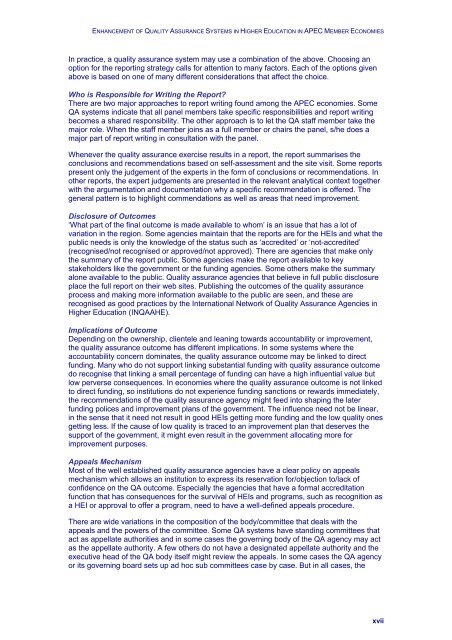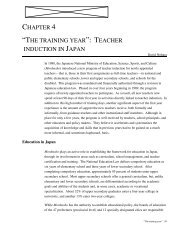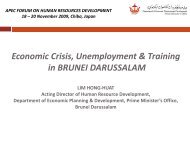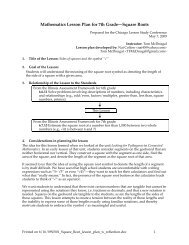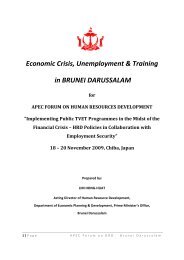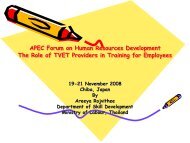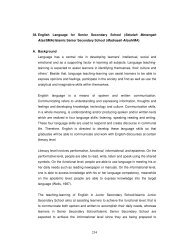Quality Assurance Systems in Asia-Pacific Economic Cooperation
Quality Assurance Systems in Asia-Pacific Economic Cooperation
Quality Assurance Systems in Asia-Pacific Economic Cooperation
You also want an ePaper? Increase the reach of your titles
YUMPU automatically turns print PDFs into web optimized ePapers that Google loves.
ENHANCEMENT OF QUALITY ASSURANCE SYSTEMS IN HIGHER EDUCATION IN APEC MEMBER ECONOMIES<br />
In practice, a quality assurance system may use a comb<strong>in</strong>ation of the above. Choos<strong>in</strong>g an<br />
option for the report<strong>in</strong>g strategy calls for attention to many factors. Each of the options given<br />
above is based on one of many different considerations that affect the choice.<br />
Who is Responsible for Writ<strong>in</strong>g the Report?<br />
There are two major approaches to report writ<strong>in</strong>g found among the APEC economies. Some<br />
QA systems <strong>in</strong>dicate that all panel members take specific responsibilities and report writ<strong>in</strong>g<br />
becomes a shared responsibility. The other approach is to let the QA staff member take the<br />
major role. When the staff member jo<strong>in</strong>s as a full member or chairs the panel, s/he does a<br />
major part of report writ<strong>in</strong>g <strong>in</strong> consultation with the panel.<br />
Whenever the quality assurance exercise results <strong>in</strong> a report, the report summarises the<br />
conclusions and recommendations based on self-assessment and the site visit. Some reports<br />
present only the judgement of the experts <strong>in</strong> the form of conclusions or recommendations. In<br />
other reports, the expert judgements are presented <strong>in</strong> the relevant analytical context together<br />
with the argumentation and documentation why a specific recommendation is offered. The<br />
general pattern is to highlight commendations as well as areas that need improvement.<br />
Disclosure of Outcomes<br />
‘What part of the f<strong>in</strong>al outcome is made available to whom’ is an issue that has a lot of<br />
variation <strong>in</strong> the region. Some agencies ma<strong>in</strong>ta<strong>in</strong> that the reports are for the HEIs and what the<br />
public needs is only the knowledge of the status such as ‘accredited’ or ‘not-accredited’<br />
(recognised/not recognised or approved/not approved). There are agencies that make only<br />
the summary of the report public. Some agencies make the report available to key<br />
stakeholders like the government or the fund<strong>in</strong>g agencies. Some others make the summary<br />
alone available to the public. <strong>Quality</strong> assurance agencies that believe <strong>in</strong> full public disclosure<br />
place the full report on their web sites. Publish<strong>in</strong>g the outcomes of the quality assurance<br />
process and mak<strong>in</strong>g more <strong>in</strong>formation available to the public are seen, and these are<br />
recognised as good practices by the International Network of <strong>Quality</strong> <strong>Assurance</strong> Agencies <strong>in</strong><br />
Higher Education (INQAAHE).<br />
Implications of Outcome<br />
Depend<strong>in</strong>g on the ownership, clientele and lean<strong>in</strong>g towards accountability or improvement,<br />
the quality assurance outcome has different implications. In some systems where the<br />
accountability concern dom<strong>in</strong>ates, the quality assurance outcome may be l<strong>in</strong>ked to direct<br />
fund<strong>in</strong>g. Many who do not support l<strong>in</strong>k<strong>in</strong>g substantial fund<strong>in</strong>g with quality assurance outcome<br />
do recognise that l<strong>in</strong>k<strong>in</strong>g a small percentage of fund<strong>in</strong>g can have a high <strong>in</strong>fluential value but<br />
low perverse consequences. In economies where the quality assurance outcome is not l<strong>in</strong>ked<br />
to direct fund<strong>in</strong>g, so <strong>in</strong>stitutions do not experience fund<strong>in</strong>g sanctions or rewards immediately,<br />
the recommendations of the quality assurance agency might feed <strong>in</strong>to shap<strong>in</strong>g the later<br />
fund<strong>in</strong>g polices and improvement plans of the government. The <strong>in</strong>fluence need not be l<strong>in</strong>ear,<br />
<strong>in</strong> the sense that it need not result <strong>in</strong> good HEIs gett<strong>in</strong>g more fund<strong>in</strong>g and the low quality ones<br />
gett<strong>in</strong>g less. If the cause of low quality is traced to an improvement plan that deserves the<br />
support of the government, it might even result <strong>in</strong> the government allocat<strong>in</strong>g more for<br />
improvement purposes.<br />
Appeals Mechanism<br />
Most of the well established quality assurance agencies have a clear policy on appeals<br />
mechanism which allows an <strong>in</strong>stitution to express its reservation for/objection to/lack of<br />
confidence on the QA outcome. Especially the agencies that have a formal accreditation<br />
function that has consequences for the survival of HEIs and programs, such as recognition as<br />
a HEI or approval to offer a program, need to have a well-def<strong>in</strong>ed appeals procedure.<br />
There are wide variations <strong>in</strong> the composition of the body/committee that deals with the<br />
appeals and the powers of the committee. Some QA systems have stand<strong>in</strong>g committees that<br />
act as appellate authorities and <strong>in</strong> some cases the govern<strong>in</strong>g body of the QA agency may act<br />
as the appellate authority. A few others do not have a designated appellate authority and the<br />
executive head of the QA body itself might review the appeals. In some cases the QA agency<br />
or its govern<strong>in</strong>g board sets up ad hoc sub committees case by case. But <strong>in</strong> all cases, the<br />
xvii


